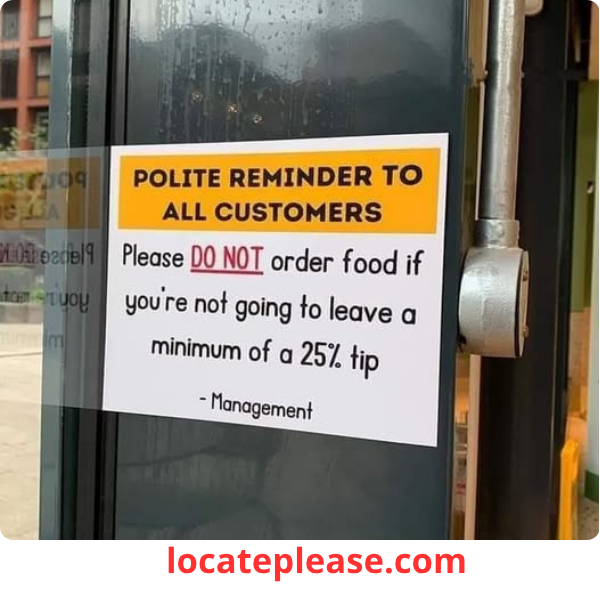A single social media post has reignited one of the most heated dining debates in years.
Dustin Anderson, a customer frustrated with what he calls the “out of control” tipping culture, recently announced he’s no longer leaving tips — especially the now-common expectation of 20% to 25% — unless he receives what he considers truly exceptional service.
His stance?
“When was the last time you got exceptional service, anywhere?”
Anderson’s comments struck a nerve — sparking a viral conversation about whether tipping has gone too far, and whether customers are being unfairly pressured to subsidize wages that should be paid by employers.
The Tipping Tipping Point
Tipping began as a voluntary gesture — a way to reward outstanding service — but in countries like the U.S., it has evolved into something far more complex:
👉 An expected surcharge
👉 A primary source of income for servers
👉 And for many customers, a source of stress and moral guilt
Anderson isn’t alone in his frustration. Many diners now report feeling pressured, guilt-tripped, or even shamed into tipping high percentages — sometimes on takeout, delivery apps that suggest 25% or more, or even for automated services.
One commenter echoed the sentiment:
“Tipping is OUT OF CONTROL. I get it — servers rely on tips — but why am I tipping 30% on a takeout order I picked up myself?”
Others questioned the logic of tipping for:
- Curbside pickup
- App-based food delivery (where drivers are often paid per delivery)
- Haircuts at home, where the stylist pays no rent or utilities
The Case Against Tipping: “It Shouldn’t Be My Job to Pay Wages”
Critics like Anderson argue that tipping has shifted from a reward to a requirement — and that customers are being forced to make up for systemic failures in the restaurant industry.
Key arguments include:
- Restaurants should pay fair wages, not rely on customers to cover the gap.
- Not every service deserves a 20%+ tip — especially if it’s basic or automated.
- The expectation to tip is becoming excessive, with apps prompting tips at multiple stages of a single order.
Anderson emphasized:
“I’m happy to pay a fair price for my meal so workers can earn a living wage — but I’m not going to automatically give 25% for average service.”
He’s not anti-worker — he’s anti-exploitation.
The Defense of Tipping: “Tips Are Our Paycheck”
On the other side, many in the service industry push back — hard.
For servers, bartenders, and delivery workers, tips aren’t bonuses — they’re survival.
A former server shared:
“I made $2.13 an hour. After taxes, I had to report 8% of my sales as a ‘tip credit’ back to the restaurant. Without tips, I would’ve been working for less than minimum wage.”
Others pointed out:
- Many states allow tipped minimum wage — often far below standard minimum wage.
- Workers in tipped roles pay taxes on estimated tips, even if they don’t earn them.
- In some cases, delivery drivers cancel orders if the tip is too low — a controversial but real practice.
One server wrote:
“Try working a 8-hour shift on your feet, managing 10 tables, dealing with rude customers — then tell me you ‘didn’t earn’ 20%.”
Many argue that until the system changes, tipping is a necessity, not a luxury.
The Bigger Picture: A Flawed System
The debate isn’t really about one man refusing to tip — it’s about a broken labor model.
Historically, tipping was imported from Europe in the 19th century and was initially seen as “un-American” — a practice associated with aristocracy and servitude. But after the Civil War, it was adopted in the U.S. as a way for employers to avoid paying wages, especially to newly freed Black workers.
Today, the U.S. remains an outlier. In many European countries, service charges are automatically included in the bill, and workers are paid fair wages. Tipping is optional and modest — a gesture, not a demand.
Emerging Trends: Are We at a Tipping Point?
Change may be coming:
- Menu prices are rising to cover labor costs — some restaurants are moving to “no-tip” models, paying higher wages and adding service charges.
- States like California and Washington have higher base wages for tipped workers, reducing reliance on tips.
- Some consumers are boycotting tip-jacking apps that suggest 30% or more.
But for now, the burden remains on the customer.
So, What Should You Do?
There’s no one-size-fits-all answer, but here are a few balanced approaches:
✅ Tip based on service, not pressure — 15–20% for good service, less for poor, more for exceptional.
✅ Understand the worker’s reality — many depend on tips to survive.
✅ Support restaurants that pay fair wages — look for “living wage” or “no-tip” establishments.
✅ Speak up about unfair practices — like being asked to tip twice in one transaction.
Final Thoughts: A System in Need of Reform
Dustin Anderson’s decision to stop tipping may be controversial — but it’s also a symptom of a deeper problem.
Tipping was meant to reward excellence — not to replace a living wage. As long as businesses profit while shifting payroll costs onto customers, the debate will rage on.
The real question isn’t whether one person should tip or not.
It’s:
Why do we, as customers, have to decide how much restaurant workers get paid?
Until that changes, the tipping tension — and the outrage on both sides — will only grow.
🍽️ Maybe the real service we need is a fairer system.










